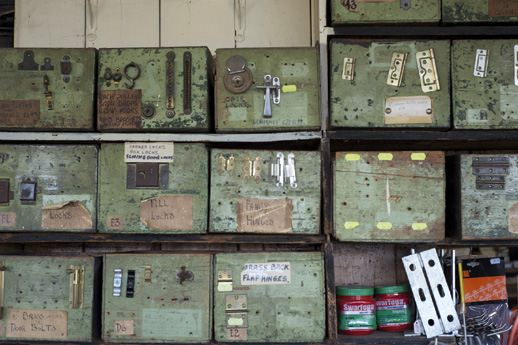 Castle Forge, Sherbourne, Dorset
Castle Forge, Sherbourne, Dorset
Visible mending: Everyday repairs in the South West (Uniformbooks)
by Steven Bond, Caitlin DeSilvey and James R. Ryan
Introduction by Sarah Pink, Foreword by Nick Hand.
212 illustrations in colour, 9 in black and white. 160pp, 234 x 142, sewn paperback with flaps.
Review by Neil Sentance
My father ran a small domestic appliance sales and repair service for forty years. When I was growing up, he would often work late into the night in his ‘workshop’, in reality a small bench tucked in at the far end of his garage. There he would recondition an ancient upright hoover or fit a new drum to a washing machine, its weighty body precariously leaning against the wall as he worked surgically on its tinny innards, the scene lit only by a rigged car lamp. The reek of mastics and WD40 and Swarfega pervaded the air. The sill of the oily window and some salvaged industrial shelf units were lined with boxes of screws, haphazardly sorted in old sweet tins. Rows of recycled Richmond sausage boxes, plywood but reinforced with metal struts, were full of hand tools – planes and bradawls, screwdrivers and pliers – and motor parts – housings and hoses and armatures. The bench had been his father’s before him and epochs of grease lined the soft chamfered surface; a vice was affixed to the edge, its lead paint peeling; black rubber vacuum cleaner belts were looped on the limbs of an old oxidising hobbing iron, its use for mending shoes long superseded. And I remember Dad’s hands: cracked, callused, rough as soot.
 Biggleston’s Hardware, Hayle, Cornwall
Biggleston’s Hardware, Hayle, Cornwall
It was a grimy world of mystery to me but the small repair shops of Cornwall, Devon, Dorset and Somerset are the subject of this typically high-value production from Axminster’s Uniformbooks. The authors are two cultural geographers from Exeter University and a photographer attached to Plymouth University. They set out to produce an archive in words and images of the small workplaces practising, in this age of built-in obsolescence and instant disposability, the crafts of fixing, mending, repairing and renewing. Their guiding lights were the tenets of EF Schumacher, he of ‘small is beautiful’ and ‘economics as if people mattered’, and the pioneering 1930s American journalist James Agee and photographer Walker Evans, and their work on the Dustbowl sharecropper communities of the Depression. The authors have recorded the visual and material culture of ‘market town high streets and front parlour studios, cold garages and sleepy suburban streets, industrial estates and converted stables’. Steven Bond’s images capture the ‘commonplace milieus’ and the ‘hidden details of familiar objects’, so quotidian as to be often missed or unspoken, as Professor Sarah Pink comments in her introduction. Time-worn processes are charted; long-serving tools portrayed in echoic, sensorial photographs. The ‘embodied practices’ of the workers themselves, the bodily movements and rituals, the intricate arrangement of tools and workspaces, described in fine-grained detail, are collated and celebrated here: witness the clock clinic, its work benches and the minute implements, spare parts and arcane machines, all used in painstaking repairs. The researchers say their work ‘made no attempt to hide the joins and seams, the stitches and solder’ – it makes for an unexpectedly mesmerising survey.
There is something oddly moving about this book: the display through made objects of our temporality and how we value the things we make everyday use of. At its heart are the vital messages of sustainability – to reduce, reuse, recycle, recover – but also the joy of craft, in the use of tools, the acquiring of skills, the knowledge of materials, as a template for living. My dad will approve.
